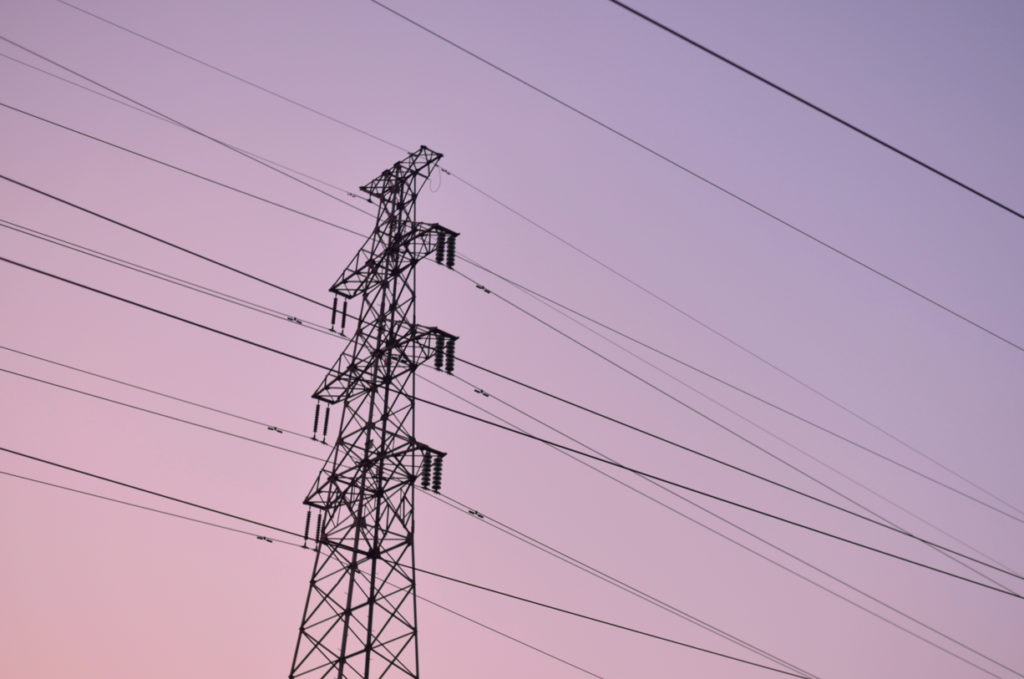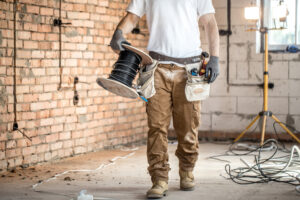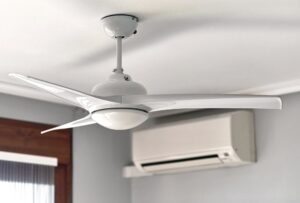What should you do when faced with a fallen power line? The risk is real and immediate: live wires can cause electrocution, fires, and power outages.
This guide provides crucial safety measures and actions to take if you come across fallen powerlines —information that can save lives and prevent further hazards.
Key Takeaways
- Always maintain a safe distance (at least 10 metres) from fallen power lines, never touch them, and report the incident immediately to local power companies or emergency services.
- Fallen powerlines pose severe electrocution risks and can lead to power outages with far-reaching consequences, like disrupting essential services and causing economic setbacks.
- Property owners and local councils are responsible for preventing power line hazards, including tree maintenance near power lines, and failure to comply with these duties can result in significant fines.
Immediate Steps When Encountering a Fallen Power Line
Encountering fallen power lines necessitates swift action to safeguard yourself and others nearby. You must stay back, report the incident, and secure the area. These may seem like simple steps, but they can significantly prevent accidents and ensure a swift response from the relevant authorities.
Stay Back, Stay Safe
When you spot a fallen power line, your first instinct might be to approach it. Maybe you want to get a closer look, or perhaps you can move it out of the way. But remember, your safety comes first. Always maintain a safe distance of at least 10 metres from the fallen power line. This is vital as power lines might still be live, representing a substantial risk of electrocution.
The dangers extend beyond the power line itself. For instance, the presence of water or moist ground near a fallen power line can facilitate the conduction of electricity, thereby extending the electrical hazard to a larger area. So, even if you think you’re at a safe distance, it’s best to stay well out of the way. And if you must move around near a fallen power line, take the following precautions:
- Stay at least 30 feet away from the fallen power line.
- Please do not touch the power line or anything in contact with it.
- If you must move, take small steps with your feet together to reduce the risk of electrical shock.
In a nutshell: Stay back, stay safe.
How to Report Fallen Powerlines
Once you’ve ensured your safety, it’s time to report fallen powerlines. But how do you do that? Here are the steps to follow:
- Consider every fallen power line as live and dangerous.
- Immediately contact your local power company, emergency services, or supplier’s emergency line immediately.
- If you’re unsure about who to call, check your electricity bill or use online tools provided by energy companies.
When you make the call, make sure to provide detailed information. Mention the location of the fallen power line and any other pertinent information, such as potential hazards or associated power outages in the area. Your timely and accurate report can significantly help in prompt and efficient response by the relevant authorities.
Ausgrid is a great way to find existing electrical outages around the local Sydney area – https://www.ausgrid.com.au/Outages/Current-Outages.
Securing the Area
After ensuring your safety and reporting the incident, the subsequent step involves securing the surrounding area of the fallen power line. This consists of setting up barriers or warning signs to prevent others from accidentally coming too close. Remember, the recommended safe distance is at least 10 metres away.
You can use physical barriers, such as insulated sleeves attached directly to the power line, or create exclusion zones that act as a ‘safety envelope’ around the power line. The aim is to prevent any accidental contact with the fallen power line until the responsible authorities arrive to handle the situation. It’s important to note that these barriers should be set up by professional electrical service workers, not the general public.

The Dangers of Fallen Powerlines
Fallen Power lines pose a significant threat that extends beyond immediate physical harm. The risk of electrocution is undoubtedly grave, but the hazards don’t stop there. Power outages caused by fallen power lines can disrupt essential services, creating a ripple effect that can severely impact communities.
Consequences of Power Outages
The impact of fallen power lines goes beyond immediate physical hazards. They can lead to power outages, disrupting essential services and systems. For instance, consider hospitals, where power is critical for running life-saving equipment. A power outage caused by a fallen power line can disrupt these machines, affecting patient care and potentially leading to severe consequences.
The disruption doesn’t stop at hospitals. Power outages from fallen power lines can significantly impact communication services, hampering emergency services and first responders’ ability to respond effectively during crises. Furthermore, power outages can result in substantial economic setbacks and impact the overall financial security of a region, showcasing the far-reaching consequences of downed power lines.
Responsibilities and Reporting
Having grasped the perils of fallen power lines and the immediate actions required, it’s time to explore the responsibilities related to power line safety. It’s not just about what you should do during an incident but also about preventing one.
Both local councils and property owners have roles to play in maintaining power lines and trees, depending on the location. In some cases, the local council may be responsible for maintaining power lines in public areas.
Local Council’s Role
Local councils have a significant role in managing fallen power lines and associated hazards. They are tasked with:
- Ensuring adherence to safety regulations
- Enacting measures to prevent power line hazards
- Overseeing vegetation near power lines
- Providing information and guidelines for activities and construction near power lines.
When addressing reports of power line hazards, local councils follow a systematic procedure. They refer to resources such as ‘Overhead and Underground Electric Lines – Information Sheet’ and the ‘Overhead and Underground Electric Lines – General Guide’ for guidance. Furthermore, they also follow established procedures for managing trees near power lines, including identifying potential hazards, assessing risks, and ensuring that clearances between power lines and tree branches adhere to industry guidelines.
Property Owners’ Duties
As a property owner, you too have a crucial role to play in preventing power line falls. Your responsibilities include ensuring that trees on your property don’t interfere with electricity service lines. This involves regular trimming and maintenance of trees near power lines.
Clearing Trees and Preventing Falls
Tree maintenance is a key aspect of preventing power line falls. Regular tree trimming and recognising risky vegetation near power lines can go a long way in avoiding incidents when a tree falls, such as trees falling on power lines.
We will now explore these factors in depth.
Tree Trimming for Safety
Tree trimming near power poles is essential for maintaining safety. It’s not just about aesthetics but about preventing trees and branches from interfering with power lines. But this task should be carried out by licensed professionals. They have the training and experience to cut tree limbs safely without risking electrocution or other accidents.
When trimming trees, specific safety protocols should be followed. Here are some guidelines to keep in mind:
- Trees should be pruned before they come within one metre of any direction of insulated service lines.
- It’s important not to prune during high winds to avoid potential accidents.
- Regular trimming prevents power outages and wildfires and reduces the risk of accidental electrocution.
Recognizing Risky Vegetation
Besides regular trimming, it’s also essential to recognize risky vegetation near power lines. Certain types of trees pose a higher risk than others. For instance, trees that are fast-growing or likely to drop large branches should be identified and removed to clear trees that could cause damage.
Remember to maintain a safe distance from power lines when planting new trees. Here are some guidelines to follow:
- Trees should be planted at least 10-15 metres away from power lines.
- Alternatively, they should be planted at a distance equal to their potential height at maturity, whichever is greater.
- This prevents them from falling on or growing too close to the lines.
Removing vegetation near power lines involves maintaining a safe distance of at least half a meter during pruning.
After the Fall: Restoring Power and Clearing Debris
Despite precautionary measures, mishaps can still happen. A storm, a fallen tree, or a damaged pole can lead to a fallen power line. In such situations, emergency response teams spring into action to restore power and clear debris.
We will now scrutinize this procedure in greater detail.
Emergency Response to Fallen Trees
On receiving reports of fallen trees on power lines, emergency response teams quickly assess the situation. The first priority is always safety. They maintain a distance of at least 10 meters from the fallen or sagging powerlines and promptly contact emergency services.
The teams employ specialized equipment, such as cranes, bucket trucks, and insulated tools, to safely remove trees from power lines. They then repair the damaged power lines, following standard protocols that involve identifying the damaged segments, their isolation, removal of the damaged parts, and installation of new ones, ensuring the service line remains uninterrupted.
Clearing Debris and Restoring Services
Once the immediate dangers are dealt with, the focus shifts to clearing debris and restoring services. Conducting debris removal after a power line fall involves maintaining a safe distance from damaged power lines and exercising caution regarding concealed lines within debris or water.
After the debris is removed, the process of restoring power begins. The restoration process places priority on public health and community facilities, with the goal of assisting the greatest number of customers as quickly as possible. The duration for power restoration can vary based on the severity of the incident, but the local electricity supply company is typically responsible for restoring power.
Underground Cables and Overhead Power Pole Considerations
Even though our primary focus has been on overhead power lines, we must mention that underground cables and overhead power poles demand distinct maintenance and protection considerations.
Protecting Underground Cables
Underground cables are often considered safer as they are not exposed to the elements or falling trees. However, they still require protection, especially during construction or digging activities. Excavating near buried power lines can result in electric shocks, explosions, fires, and injuries.
Before commencing a construction project, it’s crucial to determine the location of underground cables. Remember, power cables are typically buried at a depth of 24 inches below the soil surface, or 18 inches when protected by two inches of concrete.
What Role Does a Local Electrician Play
In the event of a fallen power line, immediate action is required. Contacting a certified electrician like Mr Sparky in Sydney is paramount to ensure safety and proper handling of the situation. Upon discovering a downed power line, do not approach or touch it, as it may still be energised and pose a severe risk of electric shock. Initiate a call to a local electrician, providing a succinct description of the incident, its location, and any observable dangers, such as sparks or exposed wires.
Note that it’s possible that an electrician is the first step, and you’ll still need to wait for emergency services to respond to the outage and come and assist your area.
During your communication with the electrician, it is essential to clearly understand if there’s been any damage to your home or if you can expect any damage while waiting for the restoration of power to your home.
Here is a professional checklist of queries to present to your local electrician regarding a fallen power line:
- Immediate Safety Precautions: What are the immediate safety precautions that I, and others in the vicinity, should undertake?
- Electrical Systems Shutdown: Is it necessary to shut down the electrical system at my home’s main circuit breaker or fuse box?
- Safety Perimeter: What safe distance should be maintained from the fallen power line?
- Usage of Electrical Devices: Should all electrical devices be refrained from use until the issue is resolved?
- Post-Repair Assessment: Following the repair, what checks will be performed on the property to ensure all electrical systems function correctly?
- Reporting Property Damage: In case of property damage, whom should I contact for reporting and assessment?
Professionalism in handling such emergencies is crucial. By asking these questions, you are ensuring the safety of all involved and facilitating a swift and effective resolution to the power outage.
Protect your powerlines
Whether a power line has recently fallen or you’re concerned about trees falling or the current condition of your power lines, it’s essential to report these concerns to the local power companies and council.
Your safety and the safety of those around you are paramount, so if you notice anything out of the ordinary, report it!
Mr Sparky is a professional Sydney electrician local to suburbs around the Inner West of Sydney and Marrickville. If you need an electrician in this area then don’t hesitate to get in touch.











